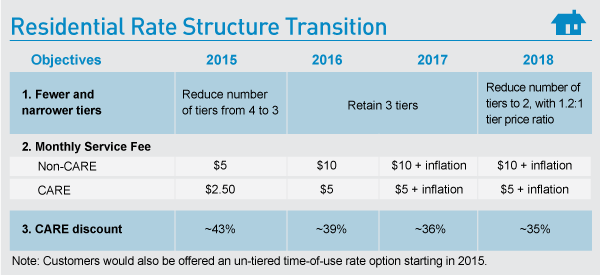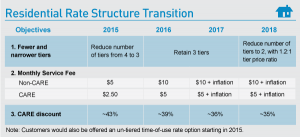PG&E and other California Utility Companies are proposing significant reforms in electric rates to make them simpler and more equitable for their customers.
The Contra Costa Times put out a story yesterday about how PG&E wants to lower electricity rates for high-use customers and raise rates for low-use customerswhich in a way focused on emotion and class warfare in terms of cost sharing—not exactly a down the middle piece.
In response, PG&E Spokesperson Tamar Sarkissian explained that some customers pay more than 36 cents for the same kilowatt-hour of electricity that costs another customer just over 13 cents—even though the cost to serve them is the same.
“We aim to reduce that gap over time so customer rates more closely reflect actual costs. Economists say these changes should have little or no effect on incentives to conserve energy,” said Sarkissan.
The reforms are aimed to reduce level the playing field for all users to pay closer to the same rate.
“These reforms won’t bring us any additional revenue or profit. They will help reverse some of the soaring rate increases faced by higher-usage customers, who have borne nearly all the growing costs for modernizing the electric grid since 2001, when the state Legislature froze rates for low-usage customers,” explained Sarkissian.
Sarkissian also disagreed with Matthew Freedman, a staff attorney with The Utility Reform Network, a consumer group. “The primary goal of this proposal is to drive up the bills for lower-usage customers.”
“Our proposal will help hundreds of thousands of low- and moderate-income customers who today subsidize bills for about 1.1 million customers from households earning $100,000 a year or more. Many low-income customers, such as retirees and families with small children, use more electricity because they stay at home much of the day, unlike white collar workers who leave home for air conditioned offices,” said Sarkissian.
PG&E Proposes Rate Reforms for Residential Electric Customers
By Jonathan Marshall
Source
There’s light at the end of the tunnel for many of California’s beleaguered electricity customers: Guided by a new state law, PG&E and other major electric utilities today (Feb. 28) filed proposals with the California Public Utilities Commission (CPUC) to make residential rates simpler and more equitable.
The proposals aim to fix many of the legacy rate problems created in the aftermath of the 2000-2001 energy crisis. Although each utility’s plan is different, all would align rates that residential customers pay more closely with the actual cost of serving them.
These regulated utilities began the reform process in late January, filing limited reform proposals to take effect in time to limit bill spikes this summer, when intense heat will drive up electricity consumption in portions of PG&E’s service area. The new, more sweeping proposals cover the years 2015-2018.
PG&E’s reform plan would not increase the utility’s revenues or profits. Instead, it responds to widespread customer dissatisfaction throughout California with the complex and inequitable system of residential electric rates that developed as a result of a state law passed in 2001.
Rates for low-usage customers, as well as low-income customers in the California Alternate Rates for Energy (CARE) program, were frozen for several years, while higher-usage customers were forced to pay ever-steeper rates for maintaining, modernizing and expanding the electric system.
Over time, this process badly warped the rate structure at California’s major utilities. PG&E now has four rate tiers, depending on consumption levels, for regular customers and three tiers for its low-income CARE customers. Needless to say, few customers find this structure easy to comprehend.
In addition, PG&E’s top tier rate (36.4 cents) is now one of the highest in the nation and nearly triple the lowest non-CARE rate (13.2 cents) — for the same kilowatt-hour of electricity. Customers who stay in the two lower tiers pay less than the average cost to serve them, so they have little incentive to conserve.
Meanwhile, rates for low-income CARE customers start even lower at 8.3 cents — less than they were back in 1993. The average CARE discount now stands at 49 percent, up from 15 percent before the energy crisis. And the annual cost of CARE subsidies, borne by other customers, has ballooned from $20 million in 2000 to $750 million today.
The CPUC won authority to start fixing those rate inequities with passage of Assembly Bill 327 last summer, supported by a broad coalition of consumer, community and taxpayer groups. The bill’s author, Assemblymember Henry T. Perea of Fresno, explained the need to bring down excessively high rates: “When it’s 110 degrees for 20 days in Fresno, nobody’s turning off their air conditioner. We’re never out of the higher tiers.”
Perea also has noted that many customers penalized by today’s high-tier rates are low-income and middle-class families who can’t afford energy-efficient homes. Other consumer advocates agree. “The rates discriminate heavily against seniors who live … in houses where energy use is high,” said Gary Passmore, vice president of the California Congress of Seniors. “They pay disproportionately.”
PG&E’s Rate Reform Proposal
To help correct many of these inequities and distortions, PG&E’s long-run rate reform proposal would:
Simplify rates and bring them closer to actual costs. The number of tiers would be reduced from four today to two by 2018. By then, the top tier rate would cost only 20 percent more than the bottom tier. In addition, the CARE discount would come down gradually to 35 percent by 2018, consistent with state law. That’s still much greater than the 15 percent discount that CARE customers enjoyed before 2000.
Spread the cost of essential infrastructure maintenance and modernization more equitably among all customers who depend on the grid. Customers would begin paying a monthly service fee of $5 in 2015, rising to $10 in 2016, to cover some of the fixed costs of maintaining and modernizing the power grid. (CARE customers would pay only half as much.) Besides supporting essential infrastructure, the fee would make it possible to bring down today’s highest electricity rates to more sustainable levels. The fee would not increase PG&E’s overall revenues.
Support informed customer choice. PG&E proposes to introduce an optional new time-of-use rate with no tiers. This would be a money-saving option for customers who can limit electricity use during high-cost periods of peak energy demand during the day. PG&E also plans to undertake extensive customer education to help users find their best rate plan and manage the transition.
“Customers want fairer, simpler rates, and this proposal represents a major step in that direction,” said Tom Bottorff, PG&E’s senior vice president for regulatory affairs. “Our goal is to continue working with regulators and consumer groups to reform rates this year and beyond, phasing in changes to smooth the transition for customers.”
Perhaps the biggest change in the proposal is the monthly service fee, which is a feature of rates for all of PG&E’s non-residential customers. Nearly all large electric utilities across the country, and many of California’s municipal utilities, have such charges for residential customers to make sure everyone contributes to the fixed costs of keeping up the electric system—costs such as metering, billing, customer service, and basic electric wires and poles. The Sacramento Municipal Utility District charges $14 a month, with plans for an increase to $20 by 2017. PG&E’s fee would be capped at $10, plus annual adjustments for inflation.
Economists, regulators, and other experts agree that such a fee is more efficient and equitable than forcing only higher energy users to bear those common costs.
As UC Davis energy economist James Bushnell wrote recently, “We have been recovering fixed costs with variable rates for so long that people do not realize what the costs really are. At one time it was perhaps reasonably fair and financially viable to pro-rate fixed charges according to a home’s energy use. As some homes approach very low levels of net energy use, that is no longer fair or financially viable.”
And as CPUC President Michael Peevey commented, “some reasonable fixed charge” for residential customers is probably inevitable. “We have to face the reality that there are some grid services everybody has to contribute to paying for.”
As it weighs reform proposals by PG&E and other utilities, and listens to comments from other parties, the Commission will doubtless think above all of the needs of California’s customers. It may want to think of Tim Lee in El Dorado County, who slashed his family’s peak monthly bills from $1,000 to $550 through close attention to energy efficiency, but still feels the bite of high rates.
He says of rate reform, “I’m all for it. Anything that can lower our monthly expenses helps.”
PG&E provided EastCountyToday permission to share there article from PG&E Currents





2 comments
This is CRAZY !! You can still save on energy costs if you are low to middle income. You just need to educate yourself on how to do it.
They are just out to punish those who went solar & the solar industry. The PUC needs to grow a pair and say NO!!
Comments are closed.